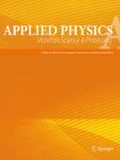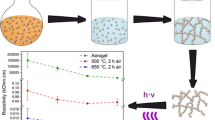Abstract
The environmental influence (with alkaline and acid components) on the luminescence character of SnO2 nanoparticles’ ensembles in a porous silicate glass matrix was studied. The established changes in the luminescence are associated with the interaction nature of alkaline or acid ions with nanoparticles in the pores of silicate glass. A sharp drop in the radiation intensity is due to the formation of unstable ammonia complexes SnO2[NH3] in the alkaline environmental with a large capture cross section. Such complexes are not formed in an acidic environmental, and a slow and smooth change in the photoluminescence intensity is associated with the penetration of HCl molecules into the pores with subsequent dissociation. A correlation was also established between the changes in luminescence behavior and the composition of the initial solution for the porous matrix impregnation. The possibility of spontaneous restoration of the initial characteristics of the investigated material is established. This and its almost absolute chemical resistance make it possible to use an ensemble of SnO2 nanoparticles in silicate porous glass as an active working material for a luminescent ammonia sensor.



Similar content being viewed by others
Code availability
Not applicable.
References
C.K. Ho, A. Robinson, D.R. Miller, M.J. Davis, Sensors (Basel) 5(2), 4 (2005)
Draft Roadmap for Next Generation Air Monitoring (2013) EPA’s Next Generation Air Monitoring Workshop Series Air Sensors 2013: Data Quality and Applications. EPA’s Research Triangle Park Campus, North Carolina. https://sites.google.com/site/airsensors2013/final-materials. https://docs.google.com/viewer?a=v&pid=sites&srcid=ZGVmYXVsdGRvbWFpbnxhaXJzZW5zb3JzMjAxM3xneDo1MzdiYTNmYjVkOGQxMDJk. Accessed 23 Sept 2020
M.J. McGrath, C.N. Scanaill, Environmental Monitoring for Health and Wellness. In: Sensor Technologies (Apress, Berkeley, CA, 2013)
H. Hayat, T. Griffiths, D. Brennan, R.P. Lewis, M. Barclay, C. Weirman, B. Philip, J.R. Searle, Sensors 19, 3648 (2019)
T.H. Gfroerer, In encyclopedia of analytical chemistry, in McGuire. ed. by R.A. Meyers (John Wiley and Sons, Newyork, 2006)
J. Lefebvre, S.P. Maruyama, Finnie Photoluminescence: Science and Applications, in Carbon Nanotubes Topics in Applied Physics. ed. by G. Dresselhaus, M.S. Dresselhaus (Springer, Berlin, Heidelberg, 2007)
L. Li, W. Wang, J. Tang, Y. Wang, J. Liu, L. Huang, Y. Wang, F. Guo, J. Wang, W. Shen, L.A. Belfiore, Nanoscale Res Lett 14, 190 (2019). https://doi.org/10.1186/s11671-019-3006-y
M. Batzill, U. Diebold, Prog Surface Sci 79, 47 (2005)
S. Das, V. Jayaraman, Prog Mat Sci 66, 112 (2014)
M. Periyasamy, A. Kar, J Mater Chem C 8, 4604 (2020)
F. Gu, Sh.F. Wang, Ch.F. Song, M.K. Lü, Y.X. Qi, G.J. Zhou, D. Xu, D.R. Yuan, Chem Phys Lett 372(3–4), 451 (2003)
S. Kar, A.P. Kundu, J Phys Chem C 115(1), 118 (2011)
D. Mohanta, M. Ahmaruzzaman, RSC Adv 6, 110996 (2016). https://doi.org/10.1039/C6RA21444D
M. Karmaoui, A.B. Jorge, P.F. McMillan, A.E. Aliev, R.C. Pullar, J.A. Labrincha, D.M. Tobaldi, ACS Omega 3(10), 13227 (2018). https://doi.org/10.1021/acsomega.8b02122
G.E. Patil, D.D. Kajale, V.B. Gaikwad et al., Int Nano Lett 2, 17 (2012). https://doi.org/10.1186/2228-5326-2-17
W.P. Lustig, S. Mukherjee, N.D. Rudd, A.V. Desai, J. Li, S.K. Ghosh, Chem Soc Rev 46, 3242–3285 (2017). https://doi.org/10.1039/C6CS00930A
S. Wei, S. Chu, Q. Lu, W. Zhou, R. Cai, Z. Shao, Chem Select 3, 4015 (2018). https://doi.org/10.1002/slct.201800411
R.S. Ningthoujama, V. Sudarsan, Appl Phys Lett 90, 173113 (2007)
T. Bürgehan, Fe2O3 and SnO2 Nanoparticles in Polymer Matrices: Towards Vinyl Hybrid Inorganic/Polymer Nano Composites Nanoparticles in Polymer Matrices: Towards Vinyl Hybrid Inorganic/Polymer Nano Composites (Koç University, Istanbul, 2007)
M. Babazadeh, M. Sheidaei, S. Sattary, Synth React Inorg Met Org Nano Met Chem 44, 819 (2014). https://doi.org/10.1080/15533174.2013.791842
IK Doycho, in Nonequilibrium Processes in Sensory Structures, ed. by V.A. Smyntyna, 120 (ONU, Odessa, 2015) (in Russian)
I.K. Doycho, V.S. Grinevych, L.M. Filevska, in Advanced Nanomaterials for Detection of CBRN, NATO Science for Peace and Security Series a: Chemistry and Biology ed. by J. Bonča, S. Kruchinin, (Springer, Dordrecht, 2020). https://doi.org/10.1007/978-94-024-2030-2_21
O.V. Mazurin, G.P. Roskova, V.I. Averianov, T.V. Antropova, Biphasic Glasses: Structure, Properties, Applications, 276 (NAUKA, Leningrad, 1991) (in Russian)
S.A. Gevelyuk, V.S. Grinevich, I.K. Doycho, Y.I. Lepikh, L.M. Filevska, J Nano Electron Phys 12(3), 03020 (2020)
H. Uchiyama, Y. Shirai, H. Kozuka, J Cryst Growth 319, 70 (2011)
H.N. Lim, R. Nurzulaikha, I. Harrison, S.S. Lim, W.T. Tan, M.C. Yeo, Int J Electrochem Sci. 6, 4329 (2011). https://www.electrochemsci.org/papers/vol6/6094329.pdf. Accessed 23 Sept 2020
O.V. Tyurin, Y.M. Bercov, S.O. Zhukov, T.F. Levitskaya, S.A. Gevelyuk, I.K. Doycho, E. Rysiakiewicz-Pasek, Opt Appl 40(2), 311 (2010). https://opticaapplicata.pwr.edu.pl/files/pdf/2010/no2/optappl_4002p311.pdf. Accessed 23 Sept 2020
S.A. Gevelyuk, V.S. Grinevych, I.K. Doycho, M. Filevska, IEEE 8th International conference on advanced optoelectronics and lasers (CAOL). Sozopol Bulgaria (2019). https://doi.org/10.1109/CAOL46282.2019.9019433
I.K. Doycho, S.A. Gevelyuk, Y.I. Lepikh, E. Rysiakiewicz-Pasek, Sensor Electronic Microsyst Technol 14(1), 31 (2017). https://doi.org/10.18524/1815-7459.2017.1.96436
I.K. Doycho, S.A. Gevelyuk, Ya. Lepikh, E. Rysiakiewicz-Pasek, Opt Appl 49(3), 427 (2019). https://opticaapplicata.pwr.edu.pl/files/pdf/2019/no3/optappl_4903p427.pdf. Accessed 23 Sept 2020
Funding
The work was carried out as a part of a project financed by the Ministry of Education and Science of Ukraine under the program “Science at Universities”.
Author information
Authors and Affiliations
Contributions
All authors contributed to the study conception and design, material preparation, data collection and analysis, the final manuscript.
Corresponding author
Ethics declarations
Conflicts of interest
Not applicable.
Ethics approval
The manuscript not submitted to other journal for simultaneous consideration. The submitted work is original and not has been published elsewhere in any form or language. Results presented clearly, honestly, and without fabrication, falsification or inappropriate data manipulation. No data, text, or theories by others are presented as if they were the author’s own.
Consent to participate
All listed authors agreed to participate in preparation and publication, approved the manuscript before submission, including the names and order of authors.
Consent for publication
All authors agreed with the content and gave explicit consent to submit. Authors obtained consent from the responsible authorities at the Odesa I.I. Mechnikov National University where the work has been carried out, before the work is submitted.
Availability of data and material
Data and materials are available at the authors’ workplace—The Odesa I.I. Mechnikov National University.
Additional information
Publisher's Note
Springer Nature remains neutral with regard to jurisdictional claims in published maps and institutional affiliations.
Rights and permissions
About this article
Cite this article
Gevelyuk, S.A., Grinevych, V.S., Doycho, I.K. et al. The active environment influence on the luminescence of SnO2 nanoparticles’ ensembles in a porous matrix. Appl. Phys. A 126, 919 (2020). https://doi.org/10.1007/s00339-020-04101-4
Received:
Accepted:
Published:
DOI: https://doi.org/10.1007/s00339-020-04101-4




